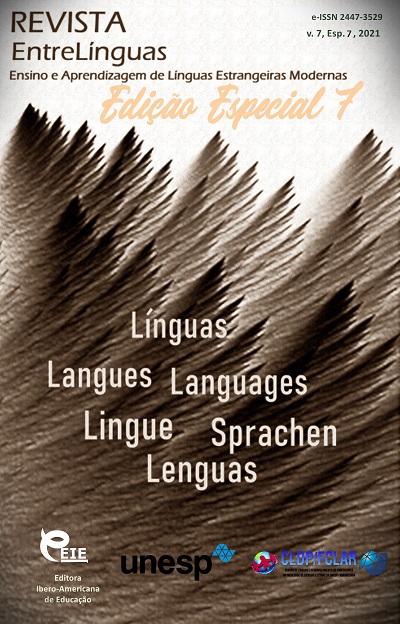The construal of the concept of memory in english
DOI:
https://doi.org/10.29051/el.v7iesp.7.16297Keywords:
Memory, Verb, SemanticsAbstract
This study treats the construal and perspectivization of the concept of memory in modern English. Using data from British National Corpus and various literary sources, we examine the lexical field of memory verbs. Employing the analytical model of Frame Semantics, the investigation demonstrates how a combination of semantic feature and frame analysis may capture the various ways that English construes the concept of memory and remembering.
Downloads
References
ARUTYUNOVA, N.D. Tipy yazykovyh znacheniy [Types of Linguistic Meanings: Evaluation. Event. Fact.]: Ed N.D.Arutyunova. – Мoscow: 340 p. (in Russian). 1988.
BARANOV, A.N., DOBROVOLSKY, D.O. Postulaty kognitivnoy semantiki [Postulates of cognitive semantics]. Izvestiya AN. Ser. lit. and yaz., 56 (1): 11-21. (in Russian). 1997.
BELYAEVSKAYA, E.G. Semanticheskaya struktyra slova v nominativnom i kommunikativnom aspektah [Semantic structure of the word in nominative and communicative aspects]: Dis....Doctor of Philology. – M.: 401 p. (in Russian). 1992.
DEMYANKOV, V.Z. Kognitivnaya lingvistika kak raznovidnost interpretiruyushchego podhoda [Cognitive linguistics as a kind of interpreting approach]. Voprosy yazykoznaniya, 4: 17-33. (in Russian). 1994.
DIRVEN, R. ET AL. The scene of linguistic action and its perspectivization by Speak, Talk, Say, and Tell, Amsterdam: Benjamins. 1982.
FAUCONNIER, G. Mental Spaces: Aspects of Meaning Construction in Natural Language. Cambridge: CUP. 1984.
FILLMORE, C., ATKINS, B. “Toward a frame-based lexicon: The semantics of risk and its neighbours”, A., Lehrer & E. Kittay eds., Frames, Fields, and contrasts: New Essays in Semantic and Lexical Organisation, 75-102. London: Erlbaum. 1992.
FILLMORE, C. “Frame Semantics”, Linguistic Society of Korea ed., Linguistics in the Morning Calm, 111-138. Seoul: Hanshin. 1982.
GIBBS, R.W. What’s Cognitive About Cognitive Linguistics. Cognitive Linguistics in the Redwoods: The Expansion of a New Paradigm in Linguistics. – Berlin, N. Y.: 27-53. 1996.
LAKOFF, G. Women, Fire, and Dangerous Things. Chicago: UCP. 1987.
LANGACKER, R. Foundations of Cognitive Grammar, Vol. 1, Theoretical Prerequisites, Stanford: SUP. 1987.
MINSKY, M. “A framework for representing knowledge”, P. Winston ed., The Pschology of Computer Vision, 211-277. New York: McGraw-Hill. 1975.
TALMY, L. Lexicalization Patterns: Semantic Structure in Lexical Forms. T. Shopen (ed.) Language Typology and Syntactic Description. Vol. Ш: Grammatical Categories and the Lexicon. – Cambridge: 46-149. 1985.
TAYLOR, J.R. Linguistic Categorization: Prototypes in Linguistic Theory. Bd. 149 – Oxford: Clarendon Press: 326.1995.
ZINCHENKO, T.P. Kognitivnaya I prikladnaya psihologiya [Cognitive and applied psychology] – Moscow: Mosk. Psychological and Social Institute, Voronezh: Publishing House of NGO "MODEK": 608 p. (in Russian). 2000.
Downloads
Published
How to Cite
Issue
Section
License

This work is licensed under a Creative Commons Attribution-NonCommercial-ShareAlike 4.0 International License.
Os manuscritos aceitos e publicados são de propriedade da Revista EntreLínguas. Os artigos publicados e as referências citadas na Revista EntreLínguas são de inteira responsabilidade de seus autores.
Transferência de direitos autorais – autorização para publicação
Caso o artigo submetido seja aprovado para publicação, já fica acordado que o(s) autor(es) autoriza(m) a UNESP a reproduzi-lo e publicá-lo na EntreLínguas, entendendo-se os termos “reprodução” e “publicação” conforme definição respectivamente dos incisos VI e I do artigo 5° da Lei 9610/98. O artigo poderá ser acessado pela rede mundial de computadores (Internet), sendo permitidas, a título gratuito, a consulta e a reprodução de exemplar do artigo para uso próprio de quem a consulta, desde que haja a citação ao texto consultado. Essa autorização de publicação 328 EntreLínguas, Araraquara, v. 1, n .2, p. 323-328, jul./dez. 2015 não tem limitação de tempo, ficando a UNESP responsável pela manutenção da identificação do(s) autor(es) do artigo. Os artigos publicados e as referências citadas na Revista EntreLínguas são de inteira responsabilidade de seus autores.











